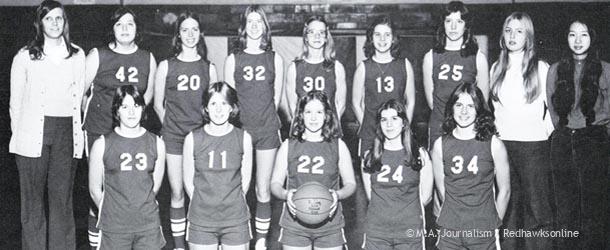Coach, health teacher looks back on forty years of female athletics beginning with Title IX
In 1975, only a few years after girls’ basketball became an official sport at Minnehaha Academy, the girls won the school’s first Tri-metro Championship. But even in this proud moment, as the president got up to give the trophy, he strongly hinted he wished the championship title had gone to a boys’ team.
“[The president] said, ‘well we finally won our first Tri-metro championship,” current health teacher and girls’ basketball coach at the time Mary Carlson remembered. “But I’m chagrinned to tell you it’s a girls’ team.”
In 1972, a federal law was enacted called the Title IX amendment, part of the Civil Rights Act, requiring equal opportunities for males and females in schools. Title IX applied to educational programs, activities and athletics. As far as athletics go, the amendment required equal athletic opportunity, finance and coaching. Once the amendment was passed, the number of girls participating in sports shot up.
Before Title IX was created, cheerleading was usually the only sports-related activity offered to girls. Cheerleading then was not like it is now with acrobatics and dance skills incorporated, but simply leading cheers at boy’s sporting events.
However, Carlson’s high school near Brainerd, MN did have an opportunity for girls to play basketball, but on a much smaller scale in a more informal manner than the boys.
“We couldn’t have uniforms because the school wasn’t going to pay for uniforms,” said Carlson.
Before Title IX, most schools also didn’t provide referees or transportation for the girls, even though they played all of the same teams as the boys.
As people began to notice the inequality in athletics and girls’ desires to play sports throughout the United States, they took action.
However, the law was only enforced at public schools. But since Minnehaha is a private school, it was not originally obligated to operate under Title IX. The process for MA was slow.
Before Title IX, Minnehaha offered girls basketball as the only female sport in 1970 apart from cheerleading.
Carlson’s first year teaching at Minnehaha was also the first year that Title IX was at the school. She coached four sports that year, both JV and varsity for each one. In the fall, she simultaneously coached both girls’ volleyball and cross-country.
“[Carlson] is a person who takes anything that life throws at her and she faces it,” said English teacher Janet Johnson. “She takes it, she deals with it that’s it.”
But the reaction to girls’ sports was not all-around positive. In the 1972 yearbook, the page headline read, “Girls’ sports invade Minnehaha.” Although not all were opposed to girls’ sports, there were some strong objections.
“That was a little bit the attitude about girls sports,” said Carlson. “It was like, ‘why are you doing this?'” The idea of girls looking athletic was not embraced as it is now.
It wasn’t until the late 1970s that the number of sports was equal between girls and boys at Minnehaha, but the funding and priorities still had not caught up.
“I still pretty much had to do my own scheduling,” said Carlson of coaching JV and varsity teams for all three seasons.
She soon had the realization that the boys’ coaches were getting paid much more than her. All the boys’ teams had separate coaches for JV and varsity while Carlson was in charge of coaching both for her girls’ sports. For a while, she had assumed she was getting paid the same amount as the boys’ coaches, but one day she saw documentation of how much coaches were getting paid and discovered that boy’s coaches were getting a significant amount more.
“I said, ‘how come I’m coaching both varsity and JV and they have a varsity coach and a JV coach?’,” asked Carlson, “‘well how come I’m not getting [the pay] combined?’ And basically the athletic director said, ‘It’s because it’s girls’ sports.'”
In his opinion, it was obvious that girls did not deserve the same as boys as far as athletics go.
However, as time progressed, more equality came. When new sports were added they were usually girls’ and boys.’ And the attitude lightened and became excited about girls sporting events.
“It just took time before people started realizing that the girls’ sports were equal in terms of how they played,” said Carlson.
She admits that the girls didn’t play as well at the beginning because most of them had never played or received proper coaching as many of the boys had. But the girls quickly improved their athletic skills to the point of their championship in the 1974-1975 season.
By the late 1970s and early 1980s, the girls’ and boys’ had the same number of teams, coaches, buses and uniform. The girls also had just as many more supporters. Game attendance was quickly rising and the school supported the girls in their athletics, which was another concern. The school didn’t want to have to fund these games if no one would come to watch, but student fans have proved them wrong.
Generally, high school sports are not big money makers for the schools so the finances turn out to be less of a concern.
Today, girls’ sports are something students become excited about and don’t often give a second thought to the fact that girls are playing sports. Minnehaha girl athletes have proven that girls can indeed play sports. For example, girls’ basketball went to state five years in a row along with many individual girls receiving awards. If Title IX had not been passed, none of these accomplishments would have been possible.

